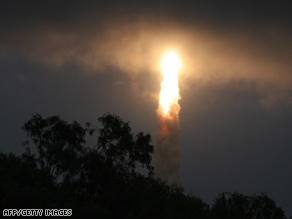NEW DELHI, India (CNN) — Scientists have turned off a number of onboard devices to cease rising temperatures inside India’s first unmanned lunar spacecraft.

The spacecraft carrying India’s first lunar probe, Chandrayaan-1, takes off from Sriharikota.
Mylswamy Annadurai, the venture supervisor for the lunar mission, informed CNN that temperatures aboard Chandrayaan-1 had risen to 49 levels Celsius (120 levels Fahrenheit).
The rise occurred because the spacecraft, the moon — which is in orbit — and the solar aligned, a phenomenon that Annadurai stated was not sudden and would seemingly final till the top of December.
“We turned off the programs (on board) that aren’t wanted to be on,” Annadurai stated, ruling out the potential for injury, including that the temperature was now right down to 40 levels Celsius (104 levels Fahrenheit).
The warmth aboard Chandrayaan-1 mustn’t exceed 50 levels Celsius (122 levels Fahrenheit), Annadurai stated, however insisted that the orbiter is designed to resist as much as 60 levels Celsius (140 levels Fahrenheit).
Chandrayaan-1 – Chandrayaan means “moon craft” in Sanskrit – was efficiently launched from southern India on 22 October. ![]() Watch the launch of India’s first lunar mission »
Watch the launch of India’s first lunar mission »
Its two-year mission is to take high-resolution, three-dimensional photographs of the moon’s floor, particularly the completely shadowed polar areas. It’ll additionally search for proof of water or ice and attempt to establish the chemical composition of sure lunar rocks, the group stated.
Earlier this month, the Moon Influence Probe separated from Chandrayaan-1 and efficiently landed on the Moon’s floor.
Officers say the television-sized probe, which is adorned with a portray of the Indian flag, hit the moon’s floor at a pace of 5,760 kilometers per hour (3,579 mph).

It transmitted information to Chandrayaan-1 earlier than affect, however was not supposed to be retrieved after that.
Chandrayaan-1 carries payloads from america, the European Union and Bulgaria. India plans to share mission information with different packages, together with NASA.


